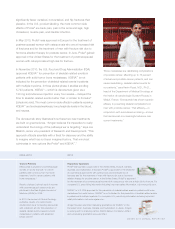Amgen 2010 Annual Report Download - page 19
Download and view the complete annual report
Please find page 19 of the 2010 Amgen annual report below. You can navigate through the pages in the report by either clicking on the pages listed below, or by using the keyword search tool below to find specific information within the annual report.• CMS engaged in a number of activities to examine the use of ESAs in certain patients with kidney disease,
including holding a March 2010 meeting of the Medicare Evidence Development & Coverage Advisory
Committee (“MEDCAC”), opening a National Coverage Analysis (“NCA”) in June 2010 to examine the use
of ESAs to manage anemia in patients with chronic kidney disease (“CKD”) and dialysis-related anemia as
well as holding another MEDCAC meeting in January 2011 to review the impact of ESA use on renal
transplant graft survival.
• We announced that the FDA approved a risk evaluation and mitigation strategy (“REMS”) for ESAs that
requires, among other elements, that healthcare providers and institutions who prescribe ESAs to patients
with cancer receive additional training and document their risk discussions with their cancer patients prior to
initiating a new course of ESA therapy. Healthcare providers and institutions who fail to comply with the
REMS program requirements, including enrolling in the ESA REMS program and meeting ongoing
compliance obligations, will have their access to ESAs suspended. Beginning February 16, 2011, we must
ensure that our distributors do not ship ESAs to any healthcare provider or institution until such provider or
institution has enrolled in the ESA APPRISE (Assisting Providers and cancer Patients with Risk Information
for the Safe use of ESAs) Oncology Program.
• We are working with the FDA to determine the appropriate use of ESAs in CKD patients and to determine
any future ESA labeling changes required in connection with our Trial to Reduce Cardiovascular Events
with Aranesp»Therapy (“TREAT”) study or the October 2010 Cardiovascular and Renal Drug Advisory
Committee (“CRDAC”) meeting.
Vectibix»
• We submitted our application to the EMA for marketing authorization for the use of Vectibix»in first- and
second-line treatment of metastatic colorectal cancer (“mCRC”) in patients whose tumors contain wild-type
KRAS genes.
• We filed supplemental Biologics License Application (“BLA”) submissions with the FDA for first- and
second-line mCRC.
• We announced that a phase 3 trial evaluating Vectibix»as a first-line treatment in patients with recurrent
and/or metastatic squamous cell head and neck cancer failed to meet its primary endpoint.
Other Developments
• We initiated a phase 3 study in recurrent ovarian cancer for AMG 386.
• We announced plans to begin a phase 3 study in first-line metastatic pancreatic cancer for ganitumab
(AMG 479).
• We announced that we anticipate data for a phase 3 motesanib study for advanced non small cell lung cancer
(“NSCLC”) in the first half of 2011.
• We recently announced an agreement to acquire BioVex Group, Inc. (“BioVex”). BioVex is a privately held
biotechnology company developing treatments for cancer and the prevention of infectious disease, including
OncoVEX
GM-CSF
, a novel oncology vaccine in phase 3 trials for the treatment of melanoma and head and
neck cancer. The acquisition, which is subject to customary closing conditions, is expected to close during
the three months ended March 31, 2011.
Marketed Products
We market our principal products, Aranesp», EPOGEN», Neulasta», NEUPOGEN»and ENBREL in
supportive cancer care, nephrology and inflammation. Certain of our marketed products face, and our product
candidates, if approved, are also expected to face, substantial competition, including from products marketed by
large pharmaceutical corporations, which may have greater clinical, research, regulatory, manufacturing, market-
ing, financial and human resources than we do. Our products’ competitive position among other biological and
3
























